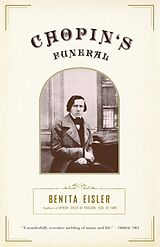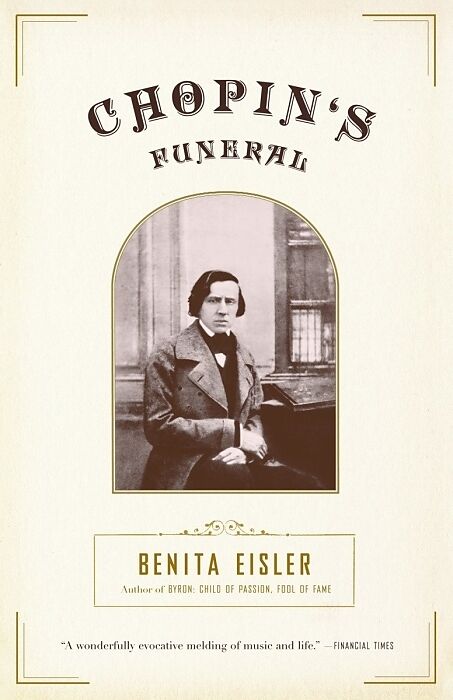Chopin's Funeral
Einband:
Kartonierter Einband
EAN:
9780375708688
Untertitel:
Englisch
Genre:
Briefe & Biografien
Autor:
Benita Eisler
Herausgeber:
Knopf Doubleday Publishing Group
Anzahl Seiten:
240
Erscheinungsdatum:
08.06.2004
ISBN:
978-0-375-70868-8
Zusatztext A wonderfully evocative melding of music and life. Financial Times [Written] with poetic insight and admirable brevity! combining analytical skill with that of a novelist. New York Times Book Review A captivating narrative. . . . [Eisler] manages to infuse cultural history with heartbreak. New York Sun Psychologically compelling. . . . Eisler writes beautifully about Chopin's music. -- The Christian Science Monitor Informationen zum Autor Benita Eisler is the author of O'Keeffe and Stieglitz: An American Romance and Byron: Child of Passion, Fool of Fame . She lives in New York City. Klappentext Frédéric Chopin's reputation as one of the Great Romantics endures, but as Benita Eisler reveals in her elegant and elegiac biography, the man was more complicated than his iconic image. A classicist, conservative, and dandy who relished his conquest of Parisian society, the Polish émigré was for a while blessed with genius, acclaim, and the love of Europe's most infamous woman writer, George Sand. But by the age of 39, the man whose brilliant compositions had thrilled audiences in the most fashionable salons lay dying of consumption, penniless and abandoned by his lover. In the fall of 1849, his lavish funeral was attended by thousandsbut not by George Sand. In this intimate portrait of an embattled man, Eisler tells the story of a turbulent love affair, of pain and loss redeemed by art, and of worldsboth private and publicconvulsed by momentous change. Leseprobe ONE Lacrymosa ies illa: "What weeping on that day" On a sparkling Paris morning, Tuesday, October 30, 1849, crowds poured into the square in front of the Church of the Madeleine. The occasion was the funeral of Frédéric Chopin, and for it, the entire facade of the great neoclassical temple had been draped in swags of black velvet centered with a cartouche bearing the silver-embroidered initials FC. Admission was by invitation only: Between three thousand and four thousand had received the black-bordered cards. Observing the square with its crush of carriages, the liveried grooms and sleek horses, the throngs converging on the porch, Hector Berlioz reported that "the whole of artistic and aristocratic Paris was there." But another who surveyed the crowd, the music critic for the Times of London, suspected that of the four thousand who filled the pews, a large number had been admitted just before noon, strangers to the dead man, mere bystanders even, "many of whom, perhaps, had never heard of him." If death is a mirror of life, Chopin's funeral reflected all the disjunctions of his brief existence. The most private of artists, his genius was mourned in a public event worthy of a head of state. Canonized as "angelic," a Shelleyan "poet of the keyboard," Chopin seemed to personify romanticism, and before he was buried, its myths had already embalmed him: a short and tragic life; an heroic role as Polish patriot and exile; doomed lover of the century's most notorious woman; and finally, his death from consumption, that killer of youth, beauty, genius, and of courtesans foolish enough to fall in love. In reality, he was the least romantic of artists. While the generation that had come of age just before his own in France, including the Olympian Victor Hugo, had defined romanticism as a holy war of the "moderns" (themselves) against the "ancients" (their literary elders), setting off riots in theaters to make their point, Chopin clung to the past. His musical touchstones were Haydn, Mozart-but especially Bach. He harbored doubts about Beethoven's lapses of taste, was incurious about the music of Schubert, and generally contemptuous of his other contemporaries: Schumann, Berlioz, and Liszt, towards whom his feelings were further tangled by rivalrous friendship. In ar...
#8220;A wonderfully evocative melding of music and life.” —Financial Times
“[Written] with poetic insight and admirable brevity, combining analytical skill with that of a novelist.” —New York Times Book Review
“A captivating narrative. . . . [Eisler] manages to infuse cultural history with heartbreak.” —New York Sun
“Psychologically compelling. . . . Eisler writes beautifully about Chopin’s music.” --The Christian Science Monitor
Autorentext
Benita Eisler is the author of O’Keeffe and Stieglitz: An American Romance and Byron: Child of Passion, Fool of Fame. She lives in New York City.
Klappentext
Frédéric Chopin's reputation as one of the Great Romantics endures, but as Benita Eisler reveals in her elegant and elegiac biography, the man was more complicated than his iconic image.
A classicist, conservative, and dandy who relished his conquest of Parisian society, the Polish émigré was for a while blessed with genius, acclaim, and the love of Europe's most infamous woman writer, George Sand. But by the age of 39, the man whose brilliant compositions had thrilled audiences in the most fashionable salons lay dying of consumption, penniless and abandoned by his lover. In the fall of 1849, his lavish funeral was attended by thousands—but not by George Sand.
In this intimate portrait of an embattled man, Eisler tells the story of a turbulent love affair, of pain and loss redeemed by art, and of worlds—both private and public—convulsed by momentous change.
Zusammenfassung
Frédéric Chopin’s reputation as one of the Great Romantics endures, but as Benita Eisler reveals in her elegant and elegiac biography, the man was more complicated than his iconic image.
A classicist, conservative, and dandy who relished his conquest of Parisian society, the Polish émigré was for a while blessed with genius, acclaim, and the love of Europe’s most infamous woman writer, George Sand. But by the age of 39, the man whose brilliant compositions had thrilled audiences in the most fashionable salons lay dying of consumption, penniless and abandoned by his lover. In the fall of 1849, his lavish funeral was attended by thousands—but not by George Sand.
In this intimate portrait of an embattled man, Eisler tells the story of a turbulent love affair, of pain and loss redeemed by art, and of worlds—both private and public—convulsed by momentous change.
Leseprobe
ONE
Lacrymosa ies illa: "What weeping on that day"
On a sparkling Paris morning, Tuesday, October 30, 1849, crowds poured into the square in front of the Church of the Madeleine. The occasion was the funeral of Frédéric Chopin, and for it, the entire facade of the great neoclassical temple had been draped in swags of black velvet centered with a cartouche bearing the silver-embroidered initials FC.
Admission was by invitation only: Between three thousand and four thousand had received the black-bordered cards. Observing the square with its crush of carriages, the liveried grooms and sleek horses, the throngs converging on the porch, Hector Berlioz reported that "the whole of artistic and aristocratic Paris was there." But another who surveyed the crowd, the music critic for the Times of London, suspected that of the four thousand who filled the pews, a large number had been admitted just before noon, strangers to the dead man, mere bystanders even, "many of whom, perhaps, had never heard of him."
If death is a mirror of life, Chopin's funeral reflected all the disjunctions of his brief existence. The most private of artists, his genius was mourned in a public event worthy of a head of state. Canonized as "angelic," a Shelleyan "poet of the keyboard," Chopin seemed to personify romanticism, and before he was buried, its myths had already embalmed him: a short a…

Leider konnten wir für diesen Artikel keine Preise ermitteln ...
billigbuch.ch sucht jetzt für Sie die besten Angebote ...
Die aktuellen Verkaufspreise von 6 Onlineshops werden in Realtime abgefragt.
Sie können das gewünschte Produkt anschliessend direkt beim Anbieter Ihrer Wahl bestellen.
Loading...
Die aktuellen Verkaufspreise von 6 Onlineshops werden in Realtime abgefragt.
Sie können das gewünschte Produkt anschliessend direkt beim Anbieter Ihrer Wahl bestellen.
| # | Onlineshop | Preis CHF | Versand CHF | Total CHF | ||
|---|---|---|---|---|---|---|
| 1 | Seller | 0.00 | 0.00 | 0.00 |
